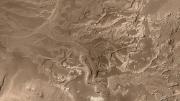Could life ever have survived on Mars? Scientists have long thought that billions of years ago, the climate of Mars was similar to that of early Earth: warm and wet. Now, a recent study by a Harvard scientist and his colleagues has concluded that Mars was likely cold and icy instead, raising new questions about the prospects for life on Earth’s closest cousin.
Assistant professor of environmental science and engineering Robin Wordsworth, along with other scientists, conducted the first direct comparison between the two scenarios—“warm and wet” and “cold and icy”—using a three-dimensional model that ran on a super-computer at Harvard. The researchers found that the “cold and icy” model did a better job of explaining the water-erosion features that have been left behind on the Martian surface, such as the distribution of valley networks.
“The use of a three-dimensional, instead of one-dimensional model, is a technical advance from other studies in the field,” said Bethany Ehlmann, an assistant professor at California Institute of Technology who reviewed the paper, “Comparison of ‘Warm and Wet’ and ‘Cold and Icy’ Scenarios for Early Mars in a 3D Climate Model” (published online on June 26 in the Journal of Geophysical Research—Planets). “Wordsworth et al. are at the top of the game here in terms of pulling in the latest three-dimensional simulations, in particular for ice.”
According to Wordsworth, the period the study targeted—three to four billion years ago—is particularly fascinating because that was when life first emerged on Earth. If Mars had hospitable climate conditions during that era, then it’s plausible, he said, that it could have sustained life as well.
A cold and icy Mars would have been inhospitable to life, he explained, but does not rule out its existence: microbes still survive in some of Earth’s coldest areas, such as Antarctica. Results of the study will inform future attempts to search for life on Mars by narrowing down possible target locations. “It tells us that if we want to look for life on Mars, looking at the surfaces may not be the best idea,” he said. “The surface would have been very inhospitable. Instead, looking at subsurface locales and specific niches might be the best approach.”
Edwin Kite, an assistant professor at the University of Chicago whose specialty is the Martian climate, said a better understanding of the planet’s historical climate can also help answer the question of how to make Mars—currently an “unpleasant” place to live—habitable again. “The better we understand Mars in the past,” he said, “the more we improve our option for changing it for a living place in the future.”
The new study raises further questions about the mechanisms that produced signs of erosion on Mars, which suggest the presence of water. Given that Mars was likely cold and icy, any extensive melting would have required a source of warmth. Where this heat came from remains a mystery. “There are discrepancies, where neither one of the two climate scenarios tested predicts valley networks,” Ehlmann said. “So we’ve got some head-scratching to do to figure out what processes were controlling those.”









